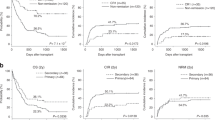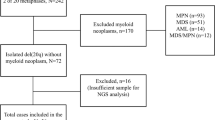Abstract
The impact of adverse risk genetic profiles on outcomes in acute myeloid leukemia (AML) patients following allogeneic hematopoietic stem cell transplantation (HCT) has not been fully elucidated. Accordingly, we have profiled somatic mutations at diagnosis using next-generation sequencing (NGS) in 178 AML patients who received allogeneic HCT. NGS revealed 598 somatic mutations in 165/178 patients (92.7%). Frequently mutated genes include DNMT3A, TET2, NPM1, RUNX1, IDH2, and FLT3. Commonly detected cytogenetic profiles include normal karyotype, trisomy 8, monosomal karyotype (MK), deletion 5, complex karyotype (CK), and monosomy 7. In univariate analyses, TP53 mutation, MK, CK, and monosomy 7 were associated with decreased overall survival (OS), relapse-free survival (RFS), and a higher relapse incidence (RI). We defined adverse molecular-genetic profile as harboring at least one of the molecular/genetic abnormalities of TP53 mutation, MK, CK, monosomy 7, and deletion 5. The patients harboring adverse molecular-genetic profile (n = 30) showed a lower 2-year OS (24.9% vs. 57.9%; p = 0.003), RFS (23.7% vs. 57.9%; p = 0.002), and higher RI (47.2% and 17.2%; p = 0.001) after HCT when compared to patients without those lesions. Multivariate analysis confirmed adverse molecular-genetic profile as an independent prognostic factor, associated with decreased OS (HR 2.19), RFS (HR 2.23), and higher RI (HR 2.94).
This is a preview of subscription content, access via your institution
Access options



Similar content being viewed by others
References
Saultz J, Garzon R. Acute myeloid leukemia: a concise review. J Clin Med. 2016;5:33.
Kouchkovsky ID, Abdul-Hay M. ‘Acute myeloid leukemia: a comprehensive review and 2016 update’. Blood Cancer J. 2016;6:e441.
Tomczak K, Czerwińska P, Wiznerowicz M. The Cancer Genome Atlas (TCGA): an immeasurable source of knowledge. Contemp Oncol. 2015;19:A68–77.
Network TCGAR. Genomic and epigenomic landscapes of adult de novo acute myeloid leukemia. N Engl J Med. 2013;368:2059–74.
Metzeler KH, Herold T, Rothenberg-Thurley M, Amler S, Sauerland MC, Görlich D, et al. Spectrum and prognostic relevance of driver gene mutations in acute myeloid leukemia. Blood. 2016;128:686–98.
Papaemmanuil E, Gerstung M, Bullinger L, Gaidzik VI, Paschka P, Roberts ND, et al. Genomic classification and prognosis in acute myeloid leukemia. N Engl J Med. 2016;374:2209–21.
Ilyas AM, Ahmad S, Faheem M, Naseer MI, Kumosani TA, Al-Qahtani MH, et al. Next generation sequencing of acute myeloid leukemia: influencing prognosis. BMC Genom. 2015;16:S5.
DiNardo CD, Cortes JE. Mutations in AML: prognostic and therapeutic implications. Hematology. 2016;2016:348–55.
Moarii M, Papaemmanuil E. Classification and risk assessment in AML: integrating cytogenetics and molecular profiling. ASH Educ Program Book. 2017;2017:37–44.
Koreth J, Schlenk R, Kopecky KJ, Honda S, Sierra J, Djulbegovic BJ, et al. Allogeneic stem cell transplantation for acute myeloid leukemia in first complete remission: systematic review and meta-analysis of prospective clinical trials. JAMA. 2009;301:2349–61.
Mohr B, Schetelig J, Schäfer-Eckart K, Schmitz N, Hänel M, Rösler W, et al. Impact of allogeneic haematopoietic stem cell transplantation in patients with abnl(17p) acute myeloid leukaemia. Brit J Haematol. 2013;161:237–44.
Guo RJ, Atenafu EG, Craddock K, Chang H. Allogeneic hematopoietic cell transplantation may alleviate the negative prognostic impact of monosomal and complex karyotypes on patients with acute myeloid leukemia. Biol Blood Marrow Transplant. 2014;20:690–5.
Oran B, Dolan M, Cao Q, Brunstein C, Warlick E, Weisdorf D. Monosomal karyotype provides better prognostic prediction after allogeneic stem cell transplantation in patients with acute myelogenous leukemia. Biol Blood Marrow Transplant. 2011;17:356–64.
Lindsley RC, Saber W, Mar BG, Redd R, Wang T, Haagenson MD, et al. Prognostic mutations in myelodysplastic syndrome after stem-cell transplantation. N Engl J Med. 2017;376:536–47.
Yoshizato T, Nannya Y, Atsuta Y, Shiozawa Y, Iijima-Yamashita Y, Yoshida K, et al. Genetic abnormalities in myelodysplasia and secondary acute myeloid leukemia: impact on outcome of stem cell transplantation. Blood. 2017;129:2347–58.
Arber DA, Orazi A, Hasserjian R, Thiele J, Borowitz MJ, Beau MML, et al. The 2016 revision to the World Health Organization classification of myeloid neoplasms and acute leukemia. Blood. 2016;127:2391–405.
Grimwade D, Hills RK, Moorman AV, Walker H, Chatters S, Goldstone AH, et al. Refinement of cytogenetic classification in acute myeloid leukemia: determination of prognostic significance of rare recurring chromosomal abnormalities among 5876 younger adult patients treated in the United Kingdom Medical Research Council trials. Blood. 2010;116:354–65.
Kanda Y. Investigation of the freely available easy-to-use software ‘EZR’ for medical statistics. Bone Marrow Transpl. 2013;48:452–8.
Grimwade D, Walker H, Oliver F, Wheatley K, Harrison C, Harrison G, et al. The importance of diagnostic cytogenetics on outcome in AML: analysis of 1,612 patients entered into the MRC AML 10 trial. The Medical Research Council Adult and Children’s Leukaemia Working Parties. Blood. 1998;92:2322–33.
Breems DA, Putten WLJV, Greef GED, Zelderen-Bhola SLV, Gerssen-Schoorl KBJ, Mellink CHM, et al. Monosomal karyotype in acute myeloid leukemia: a better indicator of poor prognosis than a complex karyotype. J Clin Oncol. 2008;26:4791–7.
Consortium 1000 Genomes Project, Auton A, Brooks LD, Durbin RM, Garrison EP, Kang HM, et al. A global reference for human genetic variation. Nature. 2015;526:68–74.
Fu W, O’Connor TD, Jun G, Kang HM, Abecasis G, Leal SM, et al. Analysis of 6,515 exomes reveals the recent origin of most human protein-coding variants. Nature. 2013;493:216–20.
Lek M, Karczewski KJ, Minikel EV, Samocha KE, Banks E, Fennell T, et al. Analysis of protein-coding genetic variation in 60,706 humans. Nature. 2016;536:285–91.
Sherry ST, Ward M-H, Kholodov M, Baker J, Phan L, Smigielski EM, et al. dbSNP: the NCBI database of genetic variation. Nucleic Acids Res. 2001;29:308–11.
Döhner H, Estey E, Grimwade D, Amadori S, Appelbaum FR, Büchner T, et al. Diagnosis and management of AML in adults: 2017 ELN recommendations from an international expert panel. Blood. 2017;129:424–47.
Wang M, Lindberg J, Klevebring D, Nilsson C, Mer AS, Rantalainen M, et al. Validation of risk stratification models in acute myeloid leukemia using sequencing-based molecular profiling. Leukemia. 2017;31:2029–36.
Slovak ML, Kopecky KJ, Cassileth PA, Harrington DH, Theil KS, Mohamed A, et al. Karyotypic analysis predicts outcome of preremission and postremission therapy in adult acute myeloid leukemia: a Southwest Oncology Group/Eastern Cooperative Oncology Group study. Blood. 2000;96:4075–83.
Byrd JC, Mrózek K, Dodge RK, Carroll AJ, Edwards CG, Arthur DC, et al. Pretreatment cytogenetic abnormalities are predictive of induction success, cumulative incidence of relapse, and overall survival in adult patients with de novo acute myeloid leukemia: results from Cancer and Leukemia Group B (CALGB 8461). Blood. 2002;100:43–4336.
Haferlach C, Alpermann T, Schnittger S, Kern W, Chromik J, Schmid C, et al. Prognostic value of monosomal karyotype in comparison to complex aberrant karyotype in acute myeloid leukemia: a study on 824 cases with aberrant karyotype. Blood. 2012;119:2122–5.
Poiré X, Labopin M, Maertens J, Yakoub-Agha I, Blaise D, Ifrah N, et al. Allogeneic stem cell transplantation in adult patients with acute myeloid leukaemia and 17p abnormalities in first complete remission: a study from the Acute Leukemia Working Party (ALWP) of the European Society for Blood and Marrow Transplantation (EBMT). J Hematol Oncol. 2017;10:20.
Castro PD, Liang JC, Nagarajan L. Deletions of chromosome 5q13.3 and 17p loci cooperate in myeloid neoplasms. Blood. 2000;95:2138–43.
Armand P, Kim HT, Zhang M-J, Perez WS, Cin PSD, Klumpp TR, et al. Classifying cytogenetics in patients with acute myelogenous leukemia in complete remission undergoing allogeneic transplantation: a Center For International Blood And Marrow Transplant Research study. Biol Blood Marrow Transplant. 2012;18:280–8.
Middeke JM, Fang M, Cornelissen JJ, Mohr B, Appelbaum FR, Stadler M, et al. Outcome of patients with abnl(17p) acute myeloid leukemia after allogeneic hematopoietic stem cell transplantation. Blood. 2014;123:2960–7.
Middeke JM, Herold S, Rücker-Braun E, Berdel WE, Stelljes M, Kaufmann M, et al. TP53 mutation in patients with high‐risk acute myeloid leukaemia treated with allogeneic haematopoietic stem cell transplantation. Brit J Haematol. 2016;172:914–22.
Yanada M, Emi N, Naoe T, Sakamaki H, Iseki T, Hirabayashi N, et al. Allogeneic myeloablative transplantation for patients aged 50 years and over. Bone Marrow Transplant. 2004;34:29–35.
Ringdén O, Horowitz MM, Gale RP, Biggs JC, Gajewski J, Rimm AA, et al. Outcome after allogeneic bone marrow transplant for leukemia in older adults. JAMA. 1993;270:57–60.
Cahn J-Y, Labopin M, Schattenberg A, Reiffers J, Willemze R, Zittoun R, et al. Allogeneic bone marrow transplantation for acute leukemia in patients over the age of 40 years. Leukemia. 1997;11:416–9.
Stelljes M, Beelen DW, Braess J, Sauerland MC, Heinecke A, Berning B, et al. Allogeneic transplantation as post-remission therapy for cytogenetically high-risk acute myeloid leukemia: landmark analysis from a single prospective multicenter trial. Haematologica. 2011;96:972–9.
Shimoni A, Hardan I, Shem-Tov N, Yeshurun M, Yerushalmi R, Avigdor A, et al. Allogeneic hematopoietic stem-cell transplantation in AML and MDS using myeloablative versus reduced-intensity conditioning: the role of dose intensity. Leukemia. 2006;20:322–8.
Lima M, de, Anagnostopoulos A, Munsell M, Shahjahan M, Ueno N, Ippoliti C, et al. Nonablative versus reduced-intensity conditioning regimens in the treatment of acute myeloid leukemia and high-risk myelodysplastic syndrome: dose is relevant for long-term disease control after allogeneic hematopoietic stem cell transplantation. Blood. 2004;104:865–72.
Wahid SFA, Ismail N-A, Mohd-Idris M-R, Jamaluddin FW, Tumian N, Sze-Wei EY, et al. Comparison of reduced-intensity and myeloablative conditioning regimens for allogeneic hematopoietic stem cell transplantation in patients with acute myeloid leukemia and acute lymphoblastic leukemia: a meta-analysis. Stem Cells Dev. 2014;23:2535–52.
Bornhäuser M, Kienast J, Trenschel R, Burchert A, Hegenbart U, Stadler M, et al. Reduced-intensity conditioning versus standard conditioning before allogeneic haemopoietic cell transplantation in patients with acute myeloid leukaemia in first complete remission: a prospective, open-label randomised phase 3 trial. Lancet Oncol. 2012;13:1035–44.
Alyea EP, Kim HT, Ho V, Cutler C, DeAngelo DJ, Stone R, et al. Impact of conditioning regimen intensity on outcome of allogeneic hematopoietic cell transplantation for advanced acute myelogenous leukemia and myelodysplastic syndrome. Biol Blood Marrow Transplant. 2006;12:1047–55.
Paun O, Lazarus HM. Allogeneic hematopoietic cell transplantation for acute myeloid leukemia in first complete remission. Curr Opin Hematol. 2012;19:95–101.
Savani BN. Transplantation in AML CR1. Blood. 2010;116:1822–3.
Gupta V, Tallman MS, Weisdorf DJ. Allogeneic hematopoietic cell transplantation for adults with acute myeloid leukemia: myths, controversies, and unknowns. Blood. 2011;117:2307–18.
Wong TN, Ramsingh G, Young AL, Miller CA, Touma W, Welch JS, et al. Role of TP53 mutations in the origin and evolution of therapy-related acute myeloid leukaemia. Nature. 2015;518:552–5.
Wattel E, Preudhomme C, Hecquet B, Vanrumbeke M, Quesnel B, Dervite I, et al. p53 mutations are associated with resistance to chemotherapy and short survival in hematologic malignancies. Blood. 1994;84:3148–57.
Acknowledgements
TK is supported by scholarship from the Natural Sciences and Engineering Research Council of Canada (NSERC) (PGS-D). ZZ acknowledges support from NSERC (RGPIN-2017-06743). DDHK acknowledges support from the Leukemia & Lymphoma Society of Canada, New Idea Award (2017-522193), and from the Princess Margaret Cancer Foundation. Lastly, authors would like to thank anonymous reviewers for providing valuable and detailed comments on our manuscript.
Author information
Authors and Affiliations
Contributions
A. Schuh and DK designed the study; GD-R, A. Schuh, and DK collected samples and performed experiments; TK, TS, J-MC, ZZ, and DK analyzed the sequencing data and performed computational analyses; GD-R, TK, IN-B, KHK, A. Schuh, and DK interpreted the data and statistical analyses; and GD-R, TK, IN-B, ZZ, A. Schuh, and DK wrote the paper. All authors reviewed and approved the paper.
Corresponding author
Ethics declarations
Conflict of interest
The authors declare no competing interests.
Additional information
Publisher’s note Springer Nature remains neutral with regard to jurisdictional claims in published maps and institutional affiliations.
Rights and permissions
About this article
Cite this article
Daher-Reyes, G., Kim, T., Novitzky-Basso, I. et al. Prognostic impact of the adverse molecular-genetic profile on long-term outcomes following allogeneic hematopoietic stem cell transplantation in acute myeloid leukemia. Bone Marrow Transplant 56, 1908–1918 (2021). https://doi.org/10.1038/s41409-021-01255-4
Received:
Revised:
Accepted:
Published:
Issue Date:
DOI: https://doi.org/10.1038/s41409-021-01255-4
This article is cited by
-
Myelodysplasia-related gene mutations are associated with favorable prognosis in patients with TP53-mutant acute myeloid leukemia
Annals of Hematology (2024)
-
TP53-mutated acute myeloid leukemia and myelodysplastic syndrome: biology, treatment challenges, and upcoming approaches
Annals of Hematology (2023)



